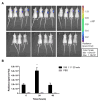Polymeric nanoparticles as cancer-specific DNA delivery vectors to human hepatocellular carcinoma
- PMID: 28351668
- PMCID: PMC5636223
- DOI: 10.1016/j.jconrel.2017.03.384
Polymeric nanoparticles as cancer-specific DNA delivery vectors to human hepatocellular carcinoma
Abstract
Hepatocellular carcinoma (HCC) is the third most deadly cancer in the US, with a meager 5-year survival rate of <20%. Such unfavorable numbers are closely related to the heterogeneity of the disease and the unsatisfactory therapies currently used to manage patients with invasive HCC. Outside of the clinic, gene therapy research is evolving to overcome the poor responses and toxicity associated with standard treatments. The inadequacy of gene delivery vectors, including poor intracellular delivery and cell specificity, are major barriers in the gene therapy field. Herein, we described a non-viral strategy for effective and cancer-specific DNA delivery to human HCC using biodegradable poly(beta-amino ester) (PBAE) nanoparticles (NPs). Varied PBAE NP formulations were evaluated for transfection efficacy and cytotoxicity to a range of human HCC cells as well as healthy human hepatocytes. To address HCC heterogeneity, nine different sources of human HCC cells were utilized. The polymeric NPs composed of 2-((3-aminopropyl)amino) ethanol end-modified poly(1,5-pentanediol diacrylate-co-3-amino-1-propanol) ('536') at a 25 polymer-to-DNA weight-to-weight ratio led to high transfection efficacy to all of the liver cancer lines, but not to hepatocytes. Each individual HCC line had a significantly higher percentage of exogenous gene expression than the healthy liver cells (P<0.01). Notably, this biodegradable end-modified PBAE gene delivery vector was not cytotoxic and maintained the viability of hepatocytes above 80%. In a HCC/hepatocyte co-culture model, in which cancerous and healthy cells share the same micro-environment, 536 25 w/w NPs specifically transfected cancer cells. PBAE NP administration to a subcutaneous HCC mouse model, established with one of the human lines tested in vitro, confirmed effective DNA transfection in vivo. PBAE-based NPs enabled high and preferential DNA delivery to HCC cells, sparing healthy hepatocytes. These biodegradable and liver cancer-selective NPs are a promising technology to deliver therapeutic genes to liver cancer.
Keywords: Carcinoma, hepatocellular; Gene therapy; Nanoparticle.
Copyright © 2017 Elsevier B.V. All rights reserved.
Figures








Similar articles
-
Student award winner in the Ph.D. category for the 2013 society for biomaterials annual meeting and exposition, april 10-13, 2013, Boston, Massachusetts : biomaterial-mediated cancer-specific DNA delivery to liver cell cultures using synthetic poly(beta-amino ester)s.J Biomed Mater Res A. 2013 Jul;101(7):1837-45. doi: 10.1002/jbm.a.34616. Epub 2013 Apr 5. J Biomed Mater Res A. 2013. PMID: 23559534 Free PMC article.
-
Synthesis and application of poly(ethylene glycol)-co-poly(β-amino ester) copolymers for small cell lung cancer gene therapy.Acta Biomater. 2016 Sep 1;41:293-301. doi: 10.1016/j.actbio.2016.05.040. Epub 2016 Jun 1. Acta Biomater. 2016. PMID: 27262740 Free PMC article.
-
Surface modified poly(β amino ester)-containing nanoparticles for plasmid DNA delivery.J Control Release. 2012 Nov 28;164(1):41-8. doi: 10.1016/j.jconrel.2012.09.020. Epub 2012 Oct 5. J Control Release. 2012. PMID: 23041278 Free PMC article.
-
Nanoparticles for targeted delivery of therapeutics and small interfering RNAs in hepatocellular carcinoma.World J Gastroenterol. 2015 Nov 14;21(42):12022-41. doi: 10.3748/wjg.v21.i42.12022. World J Gastroenterol. 2015. PMID: 26576089 Free PMC article. Review.
-
New molecular targets for functionalized nanosized drug delivery systems in personalized therapy for hepatocellular carcinoma.J Control Release. 2017 Dec 28;268:184-197. doi: 10.1016/j.jconrel.2017.10.027. Epub 2017 Oct 16. J Control Release. 2017. PMID: 29051062 Review.
Cited by
-
Carboxylated superparamagnetic Fe3O4 nanoparticles modified with 3-amino propanol and their application in magnetic resonance tumor imaging.BMC Cancer. 2023 Jan 16;23(1):54. doi: 10.1186/s12885-023-10514-0. BMC Cancer. 2023. PMID: 36647053 Free PMC article.
-
Delivery of Lipid Nanoparticles with ROS Probes for Improved Visualization of Hepatocellular Carcinoma.Biomedicines. 2023 Jun 21;11(7):1783. doi: 10.3390/biomedicines11071783. Biomedicines. 2023. PMID: 37509423 Free PMC article.
-
Non-Viral Gene Delivery to Hepatocellular Carcinoma via Intra-Arterial Injection.Int J Nanomedicine. 2023 May 11;18:2525-2537. doi: 10.2147/IJN.S390384. eCollection 2023. Int J Nanomedicine. 2023. PMID: 37197026 Free PMC article.
-
Emerging nanobiotechnology for precise theranostics of hepatocellular carcinoma.J Nanobiotechnology. 2022 Sep 29;20(1):427. doi: 10.1186/s12951-022-01615-2. J Nanobiotechnology. 2022. PMID: 36175957 Free PMC article. Review.
-
Polymeric vehicles for nucleic acid delivery.Adv Drug Deliv Rev. 2020;156:119-132. doi: 10.1016/j.addr.2020.06.014. Epub 2020 Jun 23. Adv Drug Deliv Rev. 2020. PMID: 32585159 Free PMC article. Review.
References
-
- El–Serag HB, Rudolph KL. Hepatocellular carcinoma: epidemiology and molecular carcinogenesis. Gastroenterology. 2007;132:2557–2576. - PubMed
-
- Ferlay J, Soerjomataram I, Dikshit R, Eser S, Mathers C, Rebelo M, Parkin DM, Forman D, Bray F. Cancer incidence and mortality worldwide: sources, methods and major patterns in GLOBOCAN 2012. Int J Cancer. 2015;136:E359–E386. - PubMed
-
- Hashem BES. Hepatocellular carcinoma. N Engl J Med. 2011;365:1118–1127. - PubMed
-
- Ries LAG, Eisner MP, Kosary CL, Hankey BF, Miller BA, Clegg L. Surveillance, Epidemiology, and End Results (SEER) Program SEER* Stat Database: Incidence—SEER 9 Regs Public-Use, Nov 2004 Sub (1973–2002) National Cancer Institute, Division of Cancer Control and Population Sciences, Surveillance Research Program, Cancer Statistics Branch; 2005.
-
- Venook AP, Papandreou C, Furuse J, de Guevara LL. The incidence and epidemiology of hepatocellular carcinoma: a global and regional perspective. Oncologist. 2010;15:5–13. - PubMed
MeSH terms
Substances
Grants and funding
LinkOut - more resources
Full Text Sources
Other Literature Sources
Medical
Miscellaneous

